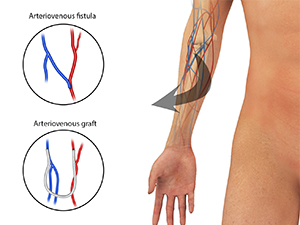Arteriovenous Fistula Creation for Dialysis Access
 Haemodialysis is a procedure performed to manage patients suffering from kidney failure. A dialysis machine takes over the function of the diseased kidneys by filtering the blood of wastes. During dialysis, you will be attached to a machine called a dialyser through a thin tube. Your blood is then drawn into the machine for filtration through a needle inserted in your arm. The blood is circulated in the dialyser and the filtered blood is returned to the body through another tube. This is usually performed three times a week, so it requires easy access to the bloodstream each time. Vascular access is a surgically created large vein that provides easy access to the bloodstream and can withstand repeated needle insertions.
Haemodialysis is a procedure performed to manage patients suffering from kidney failure. A dialysis machine takes over the function of the diseased kidneys by filtering the blood of wastes. During dialysis, you will be attached to a machine called a dialyser through a thin tube. Your blood is then drawn into the machine for filtration through a needle inserted in your arm. The blood is circulated in the dialyser and the filtered blood is returned to the body through another tube. This is usually performed three times a week, so it requires easy access to the bloodstream each time. Vascular access is a surgically created large vein that provides easy access to the bloodstream and can withstand repeated needle insertions.
There are two types of vascular accesses created for long-term use:
- Arteriovenous fistula: An abnormal connection surgically created between an artery and a vein. This allows the blood vessel to grow larger and have thicker walls, facilitating repeated puncturing. It provides good blood flow and is preferred for its lower rate of infection and clot formation, and greater longevity.
- Arteriovenous graft: A thin, flexible, synthetic tube (graft) is used to attach one end of an artery with another end of a vein. The graft is punctured to draw blood.
The vascular access is created weeks or months before you can undergo haemodialysis.







